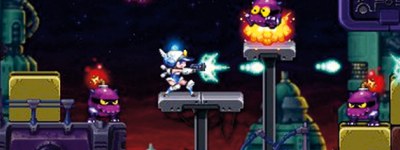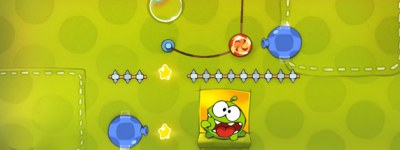Critical-GOTY 2012 pt.1
 Wednesday, January 16, 2013 at 1:19PM
Wednesday, January 16, 2013 at 1:19PM
Runner-ups

Zero Escape: Virtue's Last Reward
Zero Escape Virtue's Last Reward had a lot to measure up to being the sequel to 999: 9 Persons 9 Hours 9 Doors, one of my GOTY for 2011. Because 999 is highly unique in its combination of mystery narrative style, scifi subject matter, gameplay genre, and plot twists, many gamers were completely taken off guard. So for the sequel, everyone has very sharp expectations. This is the challenge of creating a sequel to such a game. Without spoiling anything, I think VLR does a great job twisting the formula based on the expectations established in 999.
The branching time line is a new features in Virtue's Last Reward that makes the game more accessible. It not only helps players understand the multiple paths, but it lets players travel to any previously visited node at any time. While this feature is great for reducing the amount of repetition in the game when exploring all the possibilities, it also makes the individual, linear story lines harder to follow. The time line jumpping can rearrange the presentation of the story in a way that makes keeping track of when little details happen and to which version of what characters a bit difficult.
It took me around 43 hours to beat Virtue's Last Reward, while 999 only took me about 19 hours. There's a lot of story and challenges to get through, and like 999, all the complexities add up to a meaningful though possibly convoluted conclusion. Like the Professor Layton games, the hardest part about progressing through VLR or 999 is that there isn't a set of core player skills that the game builds upon. Because the puzzles are so different from each other, one's skill progression doesn't line up with the story progression. So while the story builds to the powerful conclusion, it's easy to get hung up, stumbling on the difficulties of new learning puzzle challenges. VLR remedies this issue somewhat with a recap climax.
Virtues Last Reward is more of the same good gaming that 999 offers. I found the lack of polish in the 3DS version too glaring to overlook. For example, the stereoscopic 3D effect seems to be painted onto many of the 2D scenes in the game (as opposed to having the computer system figure it out). The result looks decent, but there are several places where the depth effects aren't properly applied creating impossible spaces where the walls are closer to you than the characters standing between you and the wall. It's jarring to the eyes. Also factor in the occasional slow down, the at times spotty touch controls, and the janky motion controls, and the gameplay experience becomes rough. Perhaps the simulataneous Vita development is to blame.
Also, the use of the dual screens in Virtue's Last Reward isn't as effective as in 999, where one screen would zoom into objects while the other would provide a perspective or map view. In VLR, both screens zoom into objects. This design decision was probably made so that players can enjoy the stereoscopic 3D effect and still interact with the objects via the touch screen. The only way to do this is to have both screens display the same image. VLR also removes the object highlighting that was such a key feedback element in 999 that reduced the systematic-blind-click-searching that plagues many adventure games. Combine with some questionable touch screen hit box alignment, and the core interaction of VLR suffers. The text is poorly formatted at times to where the information doesn't even fit on the screen.
But the hitch that irked me the most in Virtue's Last Reward isn't a bug, but a deliberate design choice. It's is the ambiguity of puzzle instructions. In 999, puzzles are very straightforward with very clear instructions given up front. But in Virtue's Last Reward, one of the main themes of the game is ambiguity. Story wise VLR works with the concept of Schrodinger's Cat as it relates to quantum mechanics and states of reality. Gameplay wise, the final puzzles in each escape rooms are designed with a bit of ambiguity so that one may read the challenge in more than one way. While this idea is extremely interesting, from a puzzle game design perspective, ambiguity can cause problems for the learning player. While normal, 999 style puzzles give clear instructions and have the player work within those rules to make informed decisions, VLR gives near-clear instructions and challenge players to try out various interpretations of the presented conditions.
The biggest downside VLR's ambiguous puzzle design is that it puts a lot of stress on the conveyance of instructions, which I don't think holds up so well especially considering that VLR is a translated game. I know that there are many particular puns and details that were lost in translation of 999. Just a little ambiguity to the instructions resulted in me doing lots of tests just to try and figure out how the systems worked and what the game was looking for instead of just solving the puzzles. Instead of teaching the player by walking through an examples like in 999, Virtue's Last Reward relies on text based ambiguities and excessive information. These design choices weaken the puzzle gameplay experience by making the challenges less about informed decisions and more about thinking outside the box, like riddles. I love how players have to be really observant and clever to get the extra "ambiguous" solution, but I wish that figuring out the "normal" solution wasn't negatively affected by at the same time. For the record, I found most of the optional-ambiguous solutions before finding the normal ones.
Overall the voice acting is great though only for the story segments, the story is rich though convoluted, the setting is intriguing yet sterile, the overall structure and style of the game is familiar yet fresh, the interface is direct yet unclear at times, and the puzzles are straightforward yet ambiguous. So Virtue's Last Reward gets a somewhat ambiguous award for games of 2012; neither in nor out of my GOTY list.

Mighty Switch Force!
Mighty Switch Force! is a highly polished game. The 2D art and animations are very good. The mechanics are simple and well tuned. The 2nd DS screen displays the radar that points in the relative direction of the closest target. The stereoscopic visuals give the interactive elements that extra bit of definition to help players distinguish between elements in the interactive foreground and the background. The music is up beat and interesting as well. After the free DLC levels, this small downloadable game is a decent challenge that lasts a few hours.
Things get very interesting when we compare the design of Mighty Switch Force! to its spiritual predecessor Mighty Flip Champs! (read more here). Instead of navigating around a 3D space by flipping through 2D-single-screen pages, players in Force! run and gun through large side-scrolling levels. While Champs! defines and obscures the 3D space by only displaying two pages of the level at a time, Force! achieves a similar obscuring effect through off screen elements. The game speed in Champs! is slow putting an emphasis on puzzle solving and deemphasizing action skills. Force! is the opposite featuring many reflex and timing challenges.
At their core Champs! and Force! are flip sides of the same puzzle-action game coin; but oddly enough, when played on a high level the ratio of puzzle gameplay to action gameplay switches (see what I did there?). This switch is most evident through the game's optional time trial challenges. To race through a level in Champs! players essentially have to plan out and memorize a path through the puzzle level. There's no time to stop and think if you want to earn an S rank. So, the time trials gameplay emphasises real-time, non-stop execution. In Force! since the game is more action based at its core with a simpler 2D space to navigate, getting through the game initially consists of straightforward action gameplay. But to get the fastest times in Force!, players have to think more about the bigger picture. Understanding how the level as a whole overlaps and connects, how the SWITCH mechanic affects elements on and off screen, and how everything in the level works on a timer creates a more interesting puzzle challenge to be solved.
One of the biggest problems I have with games like Mighty Switch Force! is that the two sub-genres are not interesting enough on their own, which makes for a lacking combination. Force! is a sub par action game in terms of aiming, shooting, platforming, and taking out enemies. The world is quantified by a large block units that don't leave a lot of room for maneuvering. So platforming challenges are limited. There are only around 5 moving enemies in the game, and they can mostly be destroyed easily by spamming fire. With yummy health pickups sprinkled throughout every level and a random chance for enemies to drop them, death is uncommon. Because there's not a lot to the action gameplay complexity wise or challenge wise, there's not a lot to experience, explore, or work toward.
On the puzzle side of Mighty Switch Force!'s design, the puzzle complexity tends to be low because only so many elements can fit on the screen at a time. The developers didn't want to have most of the important puzzle challenge elements off screen, otherwise the player might have to put more effort into keeping things straight mentally than solving the challenge. Like Cut the Rope and so many other puzzle+ genres, the puzzle challenges tend to be fairly simple and easy. The red/blue lock blocks combined with the yellow blocks create the trickier puzzle challenges in the game (see here), but for the most part there's little to figure out because the game stresses real-time timing skills (see here).
Mighty Switch Force! does a lot with its few gameplay elements, combines them well enough in the later levels, and gave me 5.5 hours of fun as I 100% completed the game. I never got all S ranks for the Champs! time trials because beating the 41 levels was satisfying enough. Plus I wasn't looking for an odd action challenge on top of the puzzle challenge. But with Force! I easily breezed through the action challenges, and, because the game has so few levels, gladly accepted the time-trials challenges afterwards. Perhaps this says something about game length, genre, and accessibility.

VVVVVV
VVVVVV was released on December 29, 2011 on the 3DS. That's close enough for me to put it with the 2012 games. The extra time trials mode and the Super Gravitron really round out this game. Also, the fan made levels that come with the game are great for comparing less quality, indie feel levels with the better design original levels. Read my review for more.

Cut The Rope
Cut the Rope looks great, sounds great, and plays well enough. To win, you cut ropes and manipulate other gadgets to guide the candy into the creature's mouth while being mindful of physics based interactions. Most of the levels are single screen comprised of only a few elements. Each stage has 3 optional stars that can be collected by causing the candy to touch the stars. Overall, the gameplay is straightforward, clean, and varied across its 300 levels. There are only a few drawbacks that keep this title from being on my GOTY list.
Perhaps Cut The Rope would work best on an iPad, but on my iPhone 4s the basic controls are problematic. The touch controls on the air bags and the turn tables are finicky. Due to the small size of the air bag and the general lack of precision from using fingers on a touch screen, using the air bag under time pressure was frustrating. In a similar way, prolonged manipulation of elements like the turn table, the rope slides, and the wheels, is challenging on the small iPhone because my finger obscures the screen, the audio feedback is lacking, and there's no tactile feedback. I raised these design concerns when I covered touch screens in my series on controller design. Other gripes include Cut the Rope's interactive elements that can, at times, move behind the HUD elements. It was very frustrating to instantly restart the level when attempting to cut a rope or pop a bubble.
Multi-touch is a part of the design, though it is rarely, if ever, required. I like finding ways to use multi-touch to solve puzzles instead of taking things step by step. Unfortunately, various elements in the game cannot be activated via multi-touch. For example, I couldn't multi-touch the air bag while cutting a rope. And the more I use multi-touch the harder it is to see the screen.
In the end, out of the 300 levels, a handful are really great: 7-24, 8-23, 9-14, 9-12, 9-13. Most of the game is solid even if its a bit easy and long winded in terms of level volume.
I was going to include The Last Rocket as a runner-up, but I realized that it was released in 2011. In part 2 I cover my GOTY.

